
If you have questions about purchasing a license call 1-800-5GO-HUNT.
Find helpful tips for preventing human/wildlife conflicts in residential and outdoor areas that attract black bears.
It is widely agreed that observation of bears is best done from a distance. When bears come too close to our homes, hunting camps, favorite fishing hole, or campsite, it ultimately results in some sort of conflict. Bear conflicts generally revolve around one thing: food. Bears are opportunistic foragers and will take full advantage of any easy meal. In most any case involving a nuisance bear, if you remove the food, you remove the problem. A primary objective of the MDWFP is to provide technical guidance to reduce human conflict with bears. As with many things, prevention is the best solution to any bear conflict.
Intentionally feeding bears habituates bears to humans. Bears that no longer have a fear of humans can become extremely dangerous. In addition to becoming comfortable around humans, the most dangerous aspect of feeding bears is that bears then associate humans with acquiring food. Bears come to expect a free meal and will come to humans to get it; the danger comes when bears demand their free meal. Feeding a bear around your home not only puts you at risk of personal injury and property damage but puts your neighbors and their property at risk as well.
For more information about bear behavior, see the "Living with Bears" section on the Bear Program page.
If a bear is seen around your home, please see the information below on preventing problems before they happen. Listed below are several things around urban and rural homes that can attract bears.
In most cases, these are highly preferred foods concentrated in a single location that is easily accessible to bears. In regard to chicken coops, bears will likely be more attracted to the chicken feed than the chickens themselves; however, the last thing anyone wants to find is a bear in their chicken coop.
Gardens, beehives, and chicken coops can be easily protected with an electric fence around the perimeter. Beekeepers across the state have had great success in protecting their hives with a single strand of poly wire about knee high off the ground. Bears can have very thick coats of fur, which could reduce the effects of the electric fence felt by the bear. Beekeepers we have spoken to have had the most success with applying peanut butter, syrup, or anything thick and sweet to the wire to make the bear touch its nose to the wire, ensuring the bear realizes the fence is nothing they need to battle with.
If your situation requires it, the electric fence can be expanded to as many strands as needed or wire netting may be used. Electric fencing materials do come at some cost but have shown to be the most effective in discouraging property destruction of bears. Learn how to construct your own electric fence.
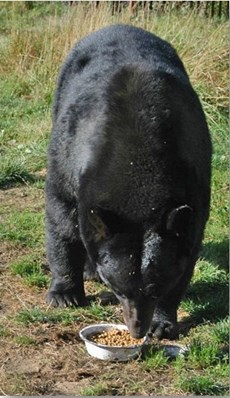 Any time bears are in the area, pet foods normally left outside should be brought inside a secure structure. Pet foods outside are a strong attractant to wandering bears looking for a meal. In addition, if your pet stays outside, the chances of a dangerous altercation between the bear and your animal increase dramatically. Pets, especially dogs, may stand their ground to defend their food, and the bear may or may not back down. If there is no food for the pet to defend, there is also no reason for the bear to instigate a useless fight.
Any time bears are in the area, pet foods normally left outside should be brought inside a secure structure. Pet foods outside are a strong attractant to wandering bears looking for a meal. In addition, if your pet stays outside, the chances of a dangerous altercation between the bear and your animal increase dramatically. Pets, especially dogs, may stand their ground to defend their food, and the bear may or may not back down. If there is no food for the pet to defend, there is also no reason for the bear to instigate a useless fight.
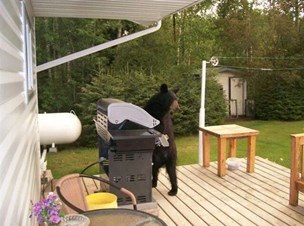 Most of us have walked outside and smelled the aroma of the neighbor down the street grilling. Bears have a sense of smell much greater than ours, so if we can smell it, you can bet a bear much farther away can, as well. Cleaning your grill or smoker thoroughly after use, being sure to remove all grease and fat, and securing it inside a structure a bear cannot get into will help ensure your grill will remain intact for the next weekend cookout.
Most of us have walked outside and smelled the aroma of the neighbor down the street grilling. Bears have a sense of smell much greater than ours, so if we can smell it, you can bet a bear much farther away can, as well. Cleaning your grill or smoker thoroughly after use, being sure to remove all grease and fat, and securing it inside a structure a bear cannot get into will help ensure your grill will remain intact for the next weekend cookout.
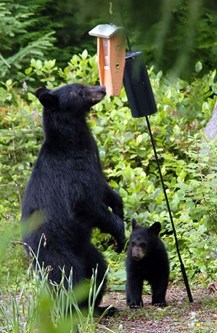 Bears are included in the term "wildlife"; bird feeders and other wildlife feeders are not selective to the animals they supply with food. Bears are very strong animals, and even bird feeders suspended far off the ground may be susceptible to a bear climbing or pulling the entire support down. As with pet foods and garbage, in an area with rare occurrence of bears, removing the feeder until the bear has moved on may resolve the issue. However, in areas where bears are common, the only solution may be to remove the feeder indefinitely.
Bears are included in the term "wildlife"; bird feeders and other wildlife feeders are not selective to the animals they supply with food. Bears are very strong animals, and even bird feeders suspended far off the ground may be susceptible to a bear climbing or pulling the entire support down. As with pet foods and garbage, in an area with rare occurrence of bears, removing the feeder until the bear has moved on may resolve the issue. However, in areas where bears are common, the only solution may be to remove the feeder indefinitely.
Any time bears are in the area, if possible, you should never leave food unattended inside your vehicle. If you choose to do so, make sure all of your windows are rolled completely up, preventing as much scent as possible from escaping, and in all cases, keep all of your vehicle doors locked. Bears are very intelligent animals and have been documented opening unlocked car doors to get to food items left inside.
Unsecured garbage is the most common attractant to bears in an area. A bag full of household garbage is a bag full of an easy meal to a bear. Securing your garbage can either be the easiest or the most difficult task when dealing with a nuisance bear. If the bear is passing through an area in which they are not normally found, securing your garbage inside until the bear has moved on may solve the entire issue. However, if you live in an area where bears are more common, additional measures such as bear-proof garbage cans or keeping your cans/dumpsters secured with an electric fence may be required.
Learn what to do if you encounter a bear in the outdoors, and about the steps you can take to be prepared.
If you encounter a bear in the outdoors, enjoy from a distance; do not approach. If you are uncomfortable with your proximity to the bear, make noise (talk, whistle, clap, etc.) so the bear knows you are there, then slowly back away.
If the bear begins to show any of the defensive-aggressive behaviors described in the "Living with Bears" section on the Bear Program page, back away slowly--do not run--and leave the area completely. If leaving is not an option, take shelter inside a secure structure, such as a building or car.
If you are outdoors with your pet and encounter a bear, follow the same steps as above. Do not allow your pet to chase or harass the bear, as this could entice the bear to attack, causing serious injury or death to you or your pet.
Yes. If you will be in an area known to have bears, red pepper sprays or labeled Bear Sprays have been successfully tested as bear deterrents.
Pepper spray has an active ingredient of capsaicinoids, which result in debilitating but nonlethal responses in bears that can include apnea, coughing, sneezing, and temporary blindness. Studies testing the effectiveness of pepper spray on free-ranging bears show that black bears respond in a variety of ways to pepper spray but that human injuries were prevented 100% of the time.
See recommendations for bear-proofing wildlife feeders, dumpsters, and unoccupied cabins or structures.
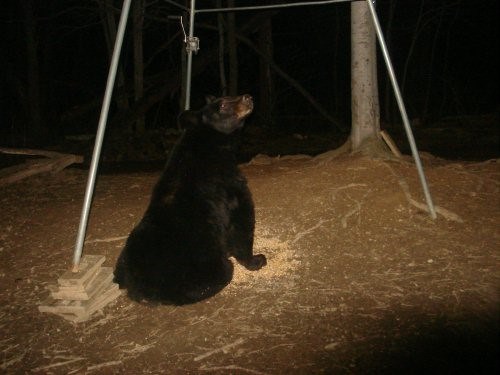 Problems associated with nuisance bear and wildlife feeders are one of the most common complaints we get. Unfortunately, there is only one surefire solution to nuisance bears destroying wildlife feeders, and that is to remove them indefinitely. Depending on where the feeder is located, steps can be taken to minimize damage, but few if any will completely solve the problem.
Problems associated with nuisance bear and wildlife feeders are one of the most common complaints we get. Unfortunately, there is only one surefire solution to nuisance bears destroying wildlife feeders, and that is to remove them indefinitely. Depending on where the feeder is located, steps can be taken to minimize damage, but few if any will completely solve the problem.
If bear sightings in your area are very rare and the bear is just passing through, leaving the feeder off until the bear has moved on may resolve the issue. In areas where bear sightings are more frequent, as soon as the feeder is refilled, the bear (or another bear) will return.
Some trial-and-error tests have been done by private landowners to try to minimize damage to feeders from bears. Elevating the feeder high beyond what any bear could reach, with heavy, smooth, metal legs that are spaced very far apart to give the feeder a wide enough stance that it cannot be overturned, seems to be the most successful measure that can be taken. Also, regular application of a slick substance such as heavy axle grease may aid in keeping the bear from climbing the legs to reach the feeder.
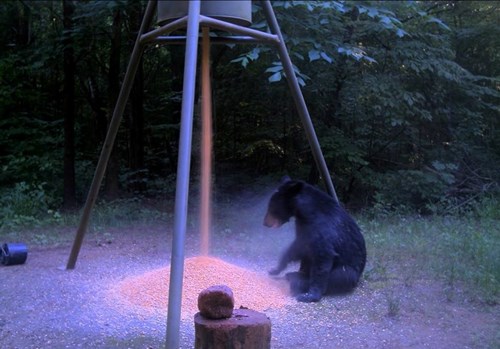 Feeders Around Cabins, Lake Houses, or Campsites (Anywhere People Stay)
Feeders Around Cabins, Lake Houses, or Campsites (Anywhere People Stay)Feeders must be removed from the area completely. Wildlife feeders in the field can be fortified to be somewhat bear resistant, but the feeder will continue to do its job of dispensing feed, where the bear still has access to it. This gives the bear a reason to come to your cabin or campsite on a regular basis, which has the same effects as intentionally feeding bears and habituating them to humans. Not only does this put you and anyone else in the area in potential danger, it also increases the likelihood of property damage, including the bear tearing into your cabin or vehicles. The take-away message is that bears, wildlife feeders, and hunting camps/lake houses do not mix.
Many extended-stay hunting camps have a community dumpster. This dumpster is generally placed in a central location for everyone to use and is picked up by a waste disposal company.
Smaller dumpsters can be modified with a reinforced locking lid that keeps the bear out, or may be replaced with a certified bear-proof dumpster. These have both been used across the U.S. with great success.
Large, open-top dumpsters can be more difficult. The only effective means of bear-proofing these larger dumpsters is to place them behind an electric fence. These fences have been used around beehives and gardens with great success. Learn how to construct your own electric fence.
Whenever your hunting camp or cabin will be left unattended for an extended period of time, it is always recommended that you do not leave any garbage (inside or out) and make sure that all wildlife feeds, bird seed, or seed for planting is securely locked up, allowing as little smell as possible to escape. Always be sure to clean up any outdoor cooking areas, such as fire pits, smokers, or barbecue grills, and secure them inside if possible. Take special care to thoroughly clean any areas where harvested animals have been processed and take offal remains far away from the cabin site.
If extra security is needed for a very long duration of absence, windows/doors may be boarded with thick plywood, or "unwelcome" mats may be constructed and placed in front of windows, doors, and at the top or bottom of staircases. Learn how to make your own "unwelcome mat".